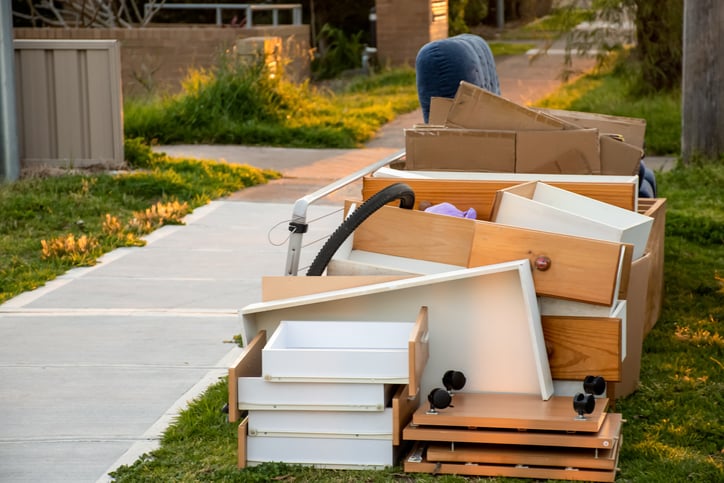Ditch the Dump! Furniture Rental Wins in a Circular Economy
Millions of tons of furniture go to landfills every year. Furniture rental may be a critical factor in saving the planet with the circular economy.
It used to be that we kept things for what seemed like an eternity.
My grandmother used the same few dishes every day for decades. When something got broken, my grandpa would get out a tube of glue and painstakingly put all of the teeny tiny pieces back together.
I remember this old teapot that could only be filled about halfway because one of the pieces didn't get put back together quite right. If you went past the second pink tulip—forget it. There was going to be water everywhere.
Somewhere in the last century, though, nearly everything became disposable. We buy something, use it for a while, then toss it. It's not surprising at all that the landfills are piled high.
It wasn't that long ago that furniture was kept in the family for generations, but recently it goes "Bye, Bye, Bye" faster than the boys from N'Sync.
Linear vs. Circular Economy
In recent years, there has been a push toward a concept called a circular economy. The Ellen MacArthur Foundation is at the forefront of this movement, which explains a circular economy like this."
In our current economy, we take material from the Earth, make products from them, and eventually throw them away as waste—the process is linear. In a circular economy, by contrast, we stop waste from being produced in the first place." Ellen MacArthur Foundation

Furniture has always been part of a linear economy. You could easily see how that would be the case. It would go from production to distribution, to consumer, to disposal over a relatively long period of time. Furniture was generational and could be passed down over many decades before the furniture was eventually thrown away.
But furniture has most definitely become more disposable over the past 30 years. Many times it only lasts a few years at best.
Recently, though, we've put more focus on sustainability and reducing our waste. Even the furniture industry is dipping its toe into that circular economy.
Source: Cleantech Group
In the circular economy, furniture goes from production to distribution to the user, just like before. But now, instead of being thrown away when a user is done with it, the piece will go back to the distribution stage. It will be cleaned and refurbished; then, eventually, it is rented again to someone new.
Once it is no longer usable, it can be dismantled, and the pieces can be recycled and used in other ways.
Why Is This Necessary?
Cool, you say. But why the push for furniture to enter the circular economy?
According to the EPA, in 1960, Americans sent about 2 million pounds of furniture to the landfill each year. But by 2017, that number had jumped to nearly 10 million pounds per year.
Clearly, there was an issue. EPA.gov

For various reasons, people don't need their furniture pieces all that long anymore, which started a trend called "fast furniture."
This furniture is usually cheaply made with flimsy materials. It doesn't last long, but it doesn't need to. It does its job for a few months–maybe a year or two. Then it gets dropped on the curb and heads to the dump when we're done with it.
How Did "Fast Furniture" Become a Thing?
When our economy became more information-based, people were less tied down to a specific location. So instead of spending their entire career in one spot with one company, they started changing jobs every few years. And a lot of times, with a new job, comes a move to a new city.
Since 2020, there's been even more movement thanks to a little thing called a global pandemic. With that, the way everyone did business changed. Even the most staunch traditionalists had to figure out how to have people working remotely.
With their feet to the fire, companies found ways for people to work from home, and the workers liked it. They liked it a lot!
Working from home allowed workers to have more flexibility, and employers saved money on rent, utilities, and office supplies. It was a win-win for many companies, and they adopted the model as a permanent solution.

People are on the move between moving jobs and the flexibility to work from anywhere.
They might stay in one place for six months or a year, then check out somewhere new.
But with that more nomadic lifestyle comes a few challenges.
For example, every new home is different. They have different layouts, different features, and different styles. The furniture that looks great in one apartment might not work so well in the next one.
There's also the expense and the hassle of moving a bunch of furniture every few months. It's much easier to get something cheap that will serve the purpose for however long you need it, and then you can return it and start fresh with the next place.
Besides all of this moving, trends in home decorating are coming and going faster than you can say "farmhouse chic."
The lifecycle of a piece of furniture has dwindled to a few years at best. And voila! That is how we end up with 10 million tons of furniture going to the landfill every year.
How Furniture Can Be Circular
As we've started to learn, furniture can be useful past its first go-round. There are various ways to reduce, reuse, and recycle (or refurbish) when it comes to furniture.
Sell it on a swap and shop page. You may no longer want a particular piece of furniture (or maybe you don't want to move it), but it could be exactly what someone else needs. Online swap pages are the perfect way to unload that piece rather than send it to the landfill.
Sell it on consignment. Just because a piece of furniture is of good quality doesn't mean it still works in your space. Selling it on consignment will allow you to re-home your unwanted furniture. It will put money in your pocket to help finance something else.
Furniture buy-back or trade-in. Recognizing the ever-growing pile of discarded furniture, some companies attempt to help the situation with a buy-back program. They will buy your old furniture pieces or take them in on trade for something new. Chances are, the store isn't going to resell your old furniture. They will likely dismantle it and then sell the pieces for use in new furniture.
Furniture Rental or Subscription. Many furniture companies, like Furniture Options, are in the business of renting furniture. You get to have high-quality, on-trend furniture in your home without spending a ton of money upfront. This way, you can have nice things but don't have to worry about what to do with them the next time you move or change your style. Just have it picked up, then get the next perfect piece.
Furniture Subscriptions And The Sharing Economy
Whether you are always on the move or change your mind frequently, subscription furniture fits perfectly in our sharing economy.
We've found a way to share everything these days – our cars, our homes, and even our clothes. So it isn't a surprise that we have also embraced the idea of sharing furniture.
With a subscription, you can rent a quality piece of furniture that you're proud to have in your home. Then when you move or get tired of it, that piece is sent back where it will be cleaned and refurbished. Soon it will be rented to someone else.

But what happens if you don't want to send it back? You can keep it. And I'm not talking about continuing to pay rent on it for an eternity either. The rent you've paid is applied toward the purchase, which is never more than the retail price. There's nothing to lose.
When it's time for a piece of furniture to be taken out of the rental rotation, Furniture Options will either sell it in their close-out section or donate it to a local charity.
Would you like to save the planet by getting furniture on subscription? Learn more about how a furniture subscription works with some of our other articles.
How Much Does Furniture Rental Cost
7 Valuable Steps Experts Recommend to Set Up Temporary Housing
Is Renting Furniture Worth It? Four Times When Renting Makes Sense


Submit a Comment